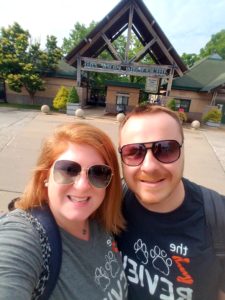
A bright red ball attached to a stick is placed at the water’s edge. Dew glistens on the lush grass beneath our feet. It’s a beautiful, cool summer morning at the Dickerson Park Zoo, or as they like to call themselves, the DPZ.
Keeper Brian, a young Herpetology Keeper at the DPZ, stands next to the pool. He holds one end of the stick in his left hand. The red ball on the other end of the stick is resting at the edge of the pool. Keeper Brian waits.
He does not have to wait long. The water in the pool begins to ripple, and in the blink of an eye the water erupts! Rico, a 40 year old American Alligator, emerges from the pool.
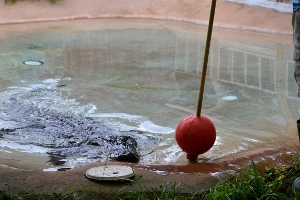
He lunges at the ball, but he does not attack it! He only touches the ball, ever-so-gingerly, with his snout.
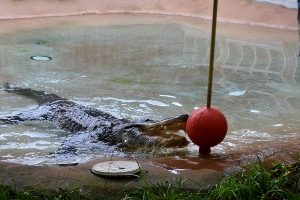
This is what Keeper Brian is asking Rico to do. Keeper Brian is helping Rico learn a technique commonly used in zoos. This technique is called, targeting.
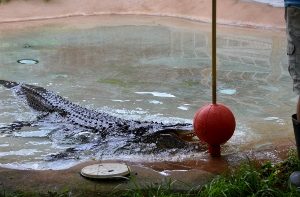
The idea behind targeting is simple: provide healthcare and wellness checks to the animals in the least stressful and least invasive way possible.
An animal is encouraged to move to a specific location and touch a “target” with part of their body so Keepers and Staff can perform wellness checks, or if needed, treatment. For their participation, the animal receives a reward.
After touching his target, Rico stepped back and waited for his reward. In Keeper Brian’s right hand was a long instrument he called “tongs”. The tongs are what Brian uses to safely give Rico his reward.
On Brian’s end of the tongs was a trigger. Brian released the trigger. This allowed a small rodent, already deceased, to be released from the other end of the tongs.
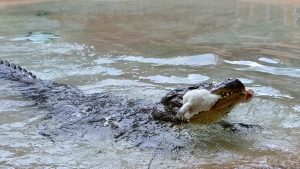
Rico’s jaws were ready. He took his reward from the tongs, and you could almost make out the smile on Rico’s face as he stepped backwards into his pool and enjoyed his reward.
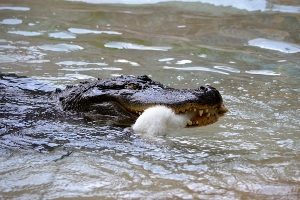
Keeper Brian was smiling too! Target training an Alligator like Rico is new for the DPZ, and Rico is progressing quite well.
The DPZ has been using target training for some time with several of their other animals. In our last visit to the DPZ (which you can read about here) we learned about targeting being used with the Giraffe herd and other DPZ animals, but targeting with Alligators was new.
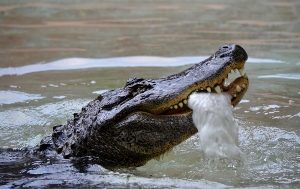
The Keepers at DPZ have recently learned, the Henry Doorly Zoo in Omaha NE has successfully target trained their eight Alligators. In Omaha, they are able to weigh, draw blood, and perform other valuable healthcare procedures while the animal is focused on touching a target. The DPZ Keepers want to try this with Rico.
For a target trained animal, no anesthesia or drugs are needed. No tackling or restraining of the animal is needed. Instead, the animal voluntarily touches a target and is rewarded while Keepers and Staff provide world class care to the animal.
Rico is learning how to target, and Keeper Brian and the other DPZ Keepers will continue to work with him. The goal is to give Rico his annual physical without restraining him as this can be stressful and dangerous for both Rico and the Keepers. Rico is not there yet, but he is making excellent progress!
Even if you can’t teach an old dog new tricks, at least you can teach a 40 year old American Alligator how to target.
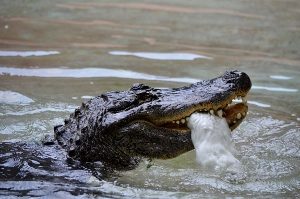
I have to confess; we didn’t start our day at the Alligator habitat. Let’s rewind just a bit to the beginning our day.
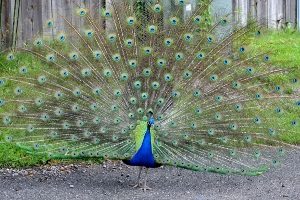
We started our zoo adventure when we met with Joey, the Marketing Director at the DPZ. We hopped on the ATV/Off Road Vehicle commonly known to most, as a golf cart and zoom…. we were off! It didn’t take long before we were doing one of our favorite things, meeting a zoo animal!
The first new friend we made on our adventure was Yona. He is an American Black Bear, and he was ready for breakfast. We also met Keeper Lauren who was making his breakfast.

Today Yona was getting a special treat, a mixture of mash potato powder, strawberry jello powder, and water with some peanut butter, raisins, and honey mixed together. Yum yum!
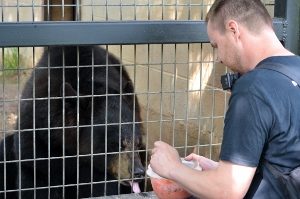
Keeper Lauren told us all about Yona and his habitat buddy, Lil Bear. Both bears had been rescued when they were young, but thanks to the DPZ, they have been able to live wonderful lives.
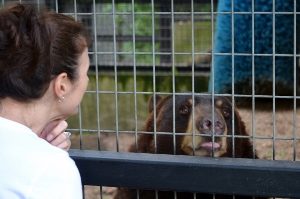
After we helped give Yona his breakfast, he decided he wanted to play with Lil Bear (who is actually the larger of the pair). They made an adorable, repeated grunting sound as they wrestled with each other. We had never heard anything like it.
We moved on to the North American River Otters. Steve has recently become a licensed drone pilot and had offered to take some pictures and videos of the zoo. Joey and Keeper Lauren thought the River Otter habitat might make a good place to try out the drone.
After calling and clearing our activities with the local airport, Steve put the drone in the air.
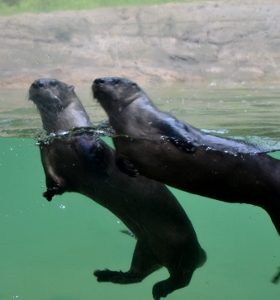
The River Otter habitat is in a beautiful part of the DPZ, and it is one of our favorite Otter habitats to visit. You can walk all the way around the habitat. Two pools are connected by a water slide the Otters enjoy using.
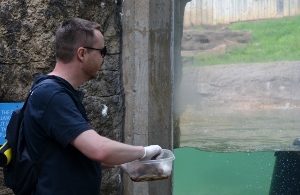
There are several windows; some of which allow you to see underwater and watch the Otters swim by. Several tall trees provide an abundance of shade to the walkways around the habitat.
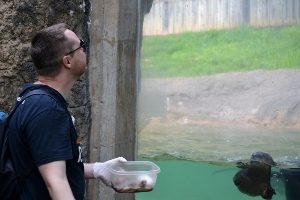
The whole setting provides the feeling of being in a forest with some adorable Otter playing in a stream. We love it!
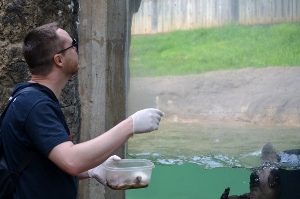

Unfortunately, something about the whole situation caused the drone to behave erratically. Almost as soon as it was airborne, the drone would drift on its own. Steve thinks it lost GPS signal which made it difficult to control. Maybe it was the tall trees. Maybe it was the materials used to construct the habitat. It might be a combination of both. In any case, Steve was able to regain just enough control to land the drone safely.
Offering drone photography to Zoos is something we plan to do moving forward. Though our inaugural drone flight was not successful, we learned a lot in a very short period of time.
We will be ready for next time! From the Otter habitat, we hopped on the golf cart again and went to see the newest and cutest baby Ringtail Lemur, Basil. When we visited last year the DPZ had a new baby at that time named Pepper.

A year later, Pepper is now the big sister, and she was jealous of the attention her baby sister was getting.
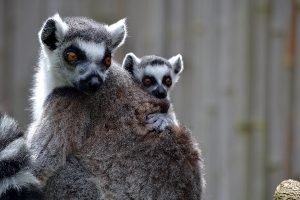
Pepper was doing everything she could to get our attention as we took pictures of Basil hanging on to their mom, Edelweiss. Pepper would get as close as she could to us, stare us down, and then run or climb to our other side where she would stare at us some more.
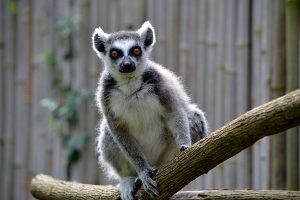
We got some amazing pictures of both Pepper and Basil as well as their parents, Edelweiss and Allister.
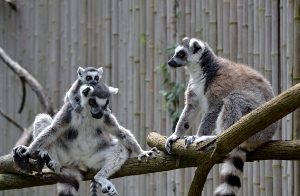
The fact that Edelweiss has been able to raise a new baby in each of the past two years is an incredible accomplishment for the DPZ. There are less than 2,400 Ringtail Lemurs left in the wild, and due to pressure caused by habitat loss, illegal pet trade, and being killed for meat, this small wild population is in rapid decline.
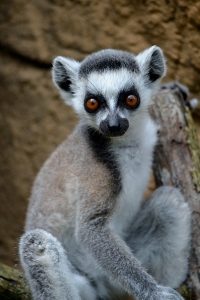
Every birth of a new Ringtail Lemur is a triumph and a vitally important contribution to the genetic diversity needed to sustain the population into the future.
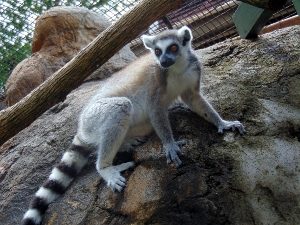
The DPZ is part of an Association of Zoos & Aquariums program called the Species Survival Plan, or the SSP. Through the SSP, the Dickerson Park Zoo works together with Zoos around the world to save as many endangered species as possible. Through the SSP, Zoos are able to find ideal genetic matches and share best practices for animal care. In the best cases, Zoos have been able to reintroduce species into the wild.
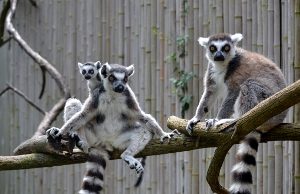
These Ringtail Lemurs are just one example of the DPZ’s contributions to the SSP. The conservation efforts of the DPZ do not end with their Lemurs.
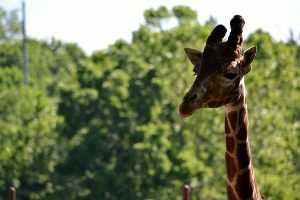
They are also participating in the Specie Survival Plan to ensure the survival of Colobus Monkeys, Giraffes, Cheetahs, and several other endangered species. In the past two years the DPZ has been able to raise new individuals in all of these species.
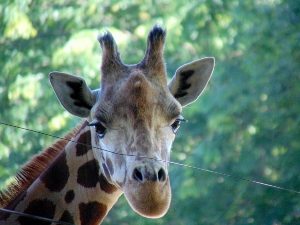
Up next was another example of an SSP program, Siamangs. We parted ways with Keeper Lauren who had introduced us to the Bears, Otters, and Lemurs, and we met up with Keeper Brandi, one of the Siamang Keepers.
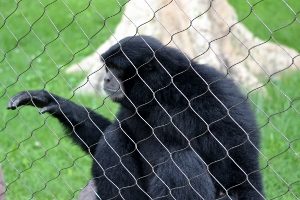
Siamangs, like Lemurs, are primates, but there are many differences between the species. Siamang is a small species of ape. So unlike Lemurs and Monkeys, they have no tail. They are incredible climbers and can be very acrobatic as they move around their habitat.
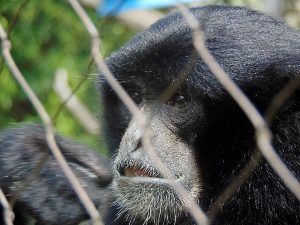
Keeper Brandi introduced us to Sebastian, the DPZ’s new young male Siamang who was swinging from rope to rope. He was really putting on a show for us.
The story behind Sebastian’s coming to the DPZ is a sad one, but it appears to be developing a happy ending. The older female Siamang, Kali, was currently off exhibit. Unfortunately, Kali’s longtime partner passed away recently. Like many Ape species, Siamangs are quite social, and thrive in the company of others.
Keeper Brandi explained to us that in the absence of another Siamang, she and some of the other Keepers spent a lot of time with Kali in the past few months to keep her company. They would sit and talk to her, watch movies with her, and even had an Ipad that Kali could play with from time to time. It was a touching story, and a perfect example of the care and attention animals get in today’s Zoo. The DPZ staff worked diligently to help Kali through this difficult time.

Additionally, the DPZ worked through the SSP to find Kali a new partner. Sebastian was identified as a good genetic match for Kali, and the DPZ is working with Sebastian to get him adjusted to his new home.
Sebastian and Kali are still getting to know each other. For now though, they are kept separate, but they have been introduced to each other through a fence, often called a “howdy”. If the introductions continue to go well, the pair will be placed together in their wonderful, enriching habitat. Who knows, maybe someday soon they will have adorable little Siamangs too.
Before we parted ways with Keeper Lauren, she told us about the Siamang Song. We had never heard of a Siamang song before, we asked Keeper Brandi to elaborate while she was working with Sebastian on targeting.
What is the Siamang Song? Each Siamang couple sings a “song” that is unique to them, and in turn they teach it to all of their offspring. When those young Siamang grow up and meet a mate, the new couple blends their own family songs into a new, unique song. This new song is then taught to any offspring the couple produces.
How cool is that?! Each Siamang family has their own song that is unique but similar to their ancestor’s songs!
The best part is: Sebastian and Kali have been singing to each other through the howdy fence! They are writing their own unique Siamang song!
From the Siamang habitat, we moved on to the American Alligator habitat where we met Keeper Brain and Rico Suave. It’s still really cool to think about Rico voluntarily coming out of his pool, hitting a target, and getting his reward. I hope the next time we go back Rico will be getting his annual checkup entirely through targeting.
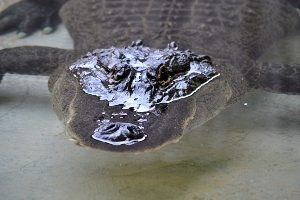
Keeper Brian took us around to the front of the Herpetarium. Before you go inside, there is a large habitat for the Aldabra Tortoises.
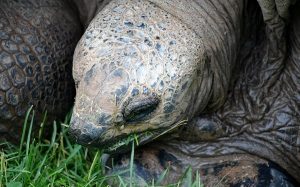
Here we met Festus, a 70 year old 450 pound Tortoise. The DPZ has Tortoise experiences where you can meet Festus for yourself.
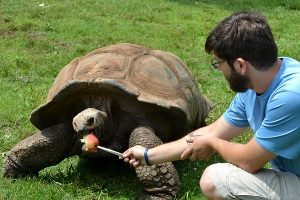
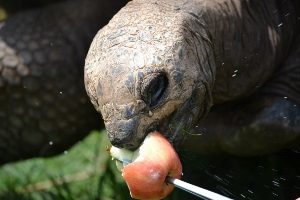
If you get the chance, we highly recommend trying it out and giving Festus a good scratch.
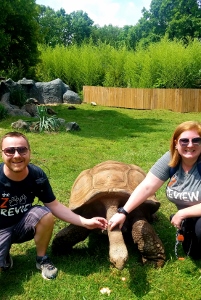
Next, we went inside the Herpetarium and Keeper Brian gave us a tour. He showed us a really neat exhibit we had not seen yet. In a dark corner was a habitat with scorpions inside. There was a button next to the exhibit that when you push it, a black light comes on.
Did you know Scorpions fluoresce, or glow, under a black light? The Scorpions were difficult to see at first as they blend into the sandy soil in their habitat, but they are easy to find when the black light comes on.
We continued through the building, looking at exhibits, and talking about all kinds of snakes, lizards, frogs, and toads.
One notable story to mention was about Annie, their resident Anaconda. That girl loves her some chicken!
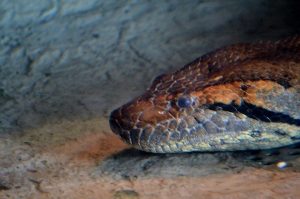
Annie normally gets rodents, but about once every two to three months, she stops eating. She’ll continue to refuse food until she gets her favorite meal, chicken. Keeper Brian called it her hunger strike for chicken.
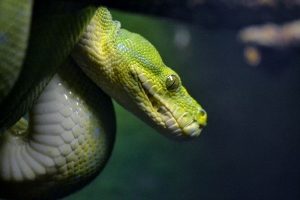
Keeper Brian also showed us some of the reptiles in the DPZ’s care behind the scenes. We met Vitamin C, the albino Monocled Cobra, and Cleo, the Ball Python.
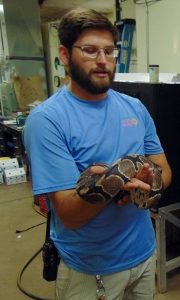
We also met a couple of Gila Monsters. Many of these animals behind the scenes had been confiscated by law enforcement or surrendered by their owners who were no longer able to care for them.
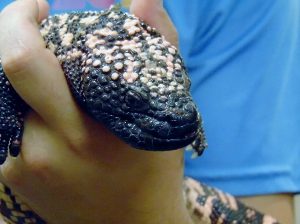
The last adventure on our tour was meeting the DPZ’s Cheetahs. Joey introduced us to Keeper Shelia who was preparing a Cheetah snack of ground meat. Once Shelia had everything ready, we walked down a path next to a sturdy fence.
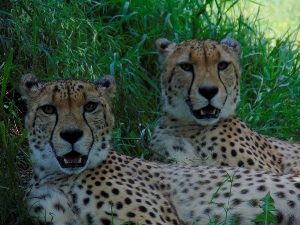
Through the fence we could see several Cheetah habitats. These are the Cheetah habitats off exhibit. These enclosures were behind the scenes, but they had natural grass, some trees, wide open space to run, and plenty of comfy, shady spots to lay. These enclosures had everything a Cheetah needs!
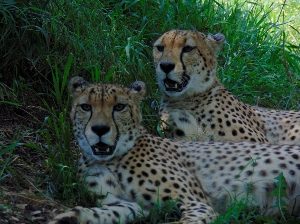
These multiple enclosures provide an opportunity for the DPZ to house multiple Cheetahs. Some male Cheetahs will form a group, called a Coalition, but many Cheetah prefer to live solitary lives. Since female cheetahs are almost always solitary, having multiple Cheetah habitats is a necessity for the well being of these animals.
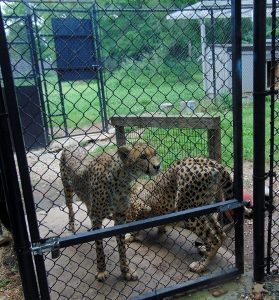
At the end of our walk down the path, we met Glenn and Wally, the DPZ’s Cheetah Coalition. They knew we were coming, and they were waiting for us. They were greeting Shelia with chirps. We had never heard this noise in person, and it was an awesome experience.

Keeper Shelia would squeeze the ground meat into a ball on the end of a bamboo stick, and feed Glenn and Wally through the fence one meat ball at a time. As she fed them, she explained that they used these meat balls as targets for the Cheetahs.
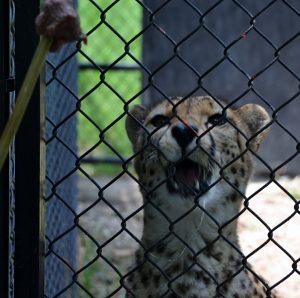
Sheila told us a story about having to treat a sore on the end of a Cheetah’s tail while someone else would have the Cheetah target the same way she was having the boys target now.
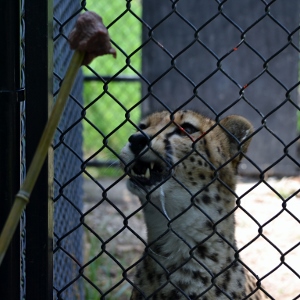
They had trained the Cheetah to place the length of his body along the fence while another keeper had the Cheetah focused on targeting. During the targeting, Keeper Shelia could use a large hook to gently pull the Cheetah’s tail through the fence and treat the wound. It was great to hear about another wonderful example of simple, voluntary, non-invasive treatment administered to an animal through stress free targeting.
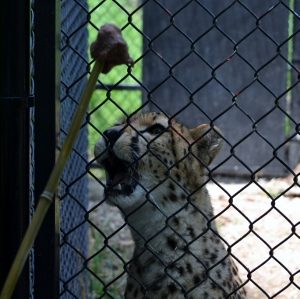
While the Cheetah boys were enjoying their snack, Keeper Shelia was able to treat their ears with a fly repellent using a simple target technique. While the Cheetah was busy pulling the meat off the end of one stick, Shelia was able to use another stick with a small dab of fly repellent ointment to transfer some ointment to the Cheetah’s ear. Without this treatment, constant fly bites on their ears could result in open sores and eventually life threatening infections.
After the boys finished their snack, we walked a little further down and met Glenn and Wally’s sister Maggie and mother Roni. If you didn’t already know, Glenn, Wally, and Maggie are litter mates born two years ago right here in the DPZ. Glenn and Wally are old enough now to be on their own and form a Coalition, and Maggie is old enough to be on her own too. However, Roni and Maggie still get along well enough to stay together for now.
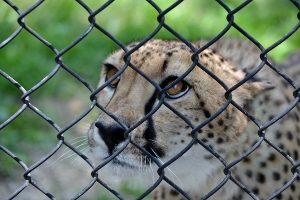
Keeper Sheila gave us one more neat piece of information before we parted ways. She said through the SSP, Zoos have learned to not break up Cheetah Coalitions. If a male is identified as a good genetic match for a female at another Zoo, arrangements will be made to bring the entire Coalition to the female or the female to the Coalition. This new practice more closely mimics interactions of Cheetah in the wild and has shown to have a higher success rate in producing cubs.
As we parted ways with Joey, we had a wonderful conversation about the future of each of our organizations. She said one last thing that really stuck out for us. Joey said, “the best and easiest thing someone can do is visit”. By visiting a Zoo, you support not only that Zoo, but also conservation efforts around the world to save the world. We couldn’t agree more.
At this point we have been doing The Zoo Review for a couple of years, and we still love seeing people’s faces and reactions when we describe the management and care of animals in today’s Zoos. When we describe the technique of targeting, people are amazed that Zoos are able to get all kinds of animals to voluntarily behave in such a beneficial way. When we explain the effort and science behind the SSP and the hope Zoos provide for the future, it gives people exactly that: hope for the future.
So, that’s our Zoo adventure! Where and when will your next zoo adventure be?